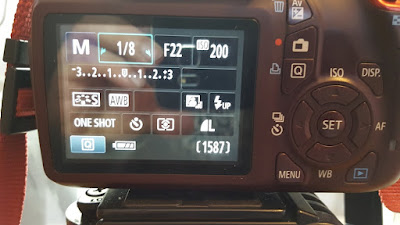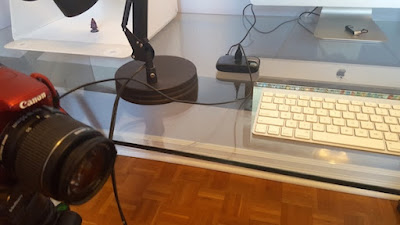So last time we discussed how I got my perfect set-up. You can imagine my frustration when I took some pictures and still they were dark and out of focus. After reading a few tutorials and some trial and error, I came up with settings which work very well for me.
So, everything needed was inside my camera, with the essential help of a tri-pod. To follow this Tutorial you need a good digital camera (mine is a Canon IOS Rebel T3) that you can put in "manual setting" and one which lets you play with Aperture, Iso and Shutter speed (exposure).
First and most important advice : DO NOT put your camera on "Macro" or "Auto" mode. I did this for years. It doesn't work for miniatures photography. What you want to do is control the settings of your camera manually. (BTW I'm no expert, what you are about to read has been picked up from the web and many tutorials. I'm a self made man ;-) ).
Aperture is ‘the opening in the lens.’
When you hit the shutter release button of your camera a hole opens up that allows your cameras image sensor to catch a glimpse of the scene you’re wanting to capture. The aperture that you set impacts the size of that hole. The larger the hole the more light that gets in – the smaller the hole the less light. Aperture is measured in ‘f-stops’. In our case, we want a a smaller hole (high number) so that everything is in focus. I go with f22.
In very basic terms, ISO is the level of sensitivity of your camera to available light. The lower the ISO number, the less sensitive it is to the light, while a higher ISO number increases the sensitivity of your camera. The ISO setting changes the sensitivity of the sensor. A low number like 100 will be crisp but will require a lot of light to expose the picture correctly. An ISO of 3000 will not require that much light but will be very grainy. I often read 400 is a good number, but I went with 200 and the results were remarkably better.
Shutter speed, also known as “exposure time”, stands for the length of time a camera shutter is open to expose light into the camera sensor. If the shutter speed is fast, it can help to freeze action completely. If the shutter speed is slow, it can create an effect called “motion blur”, where moving objects appear blurred along the direction of the motion. In our case, you want to play with the exposure meter (-2..1..0..1..+2). This is where I had so much difficulty. I kept changing the shutter speed setting until the cursor was on 0, but that always gave me too dark of a picture. Took me a while to figure that one out! Now I over exposure on the exposure metre about two clicks to get a brighter picture and a whiter background (so +2 instead of 0).
However, the long shutter speed means that, if you are holding the camera the picture will be blurry because of all the camera shake. This is where the Tri-pod comes into play, because we are going to use a long timer; with a long shutter speed just pressing the button can move the camera. The timer eliminates that. I use a full 10 seconds timer. You might say it's annoyingly too long, but honestly with all of the settings described above I rarely take more than 2-3 pictures of any subject to find my perfect picture. So basically 20-30 seconds per good picture is something I can live with!
Officially, I'm still missing two things; a better background (I like blue gradiant, although my current white works just fine) which I ordered from a recent kickstarter, and something to work on my white balance. But I'm a little lazy at times, so I let my Mac's IPhoto deal with my white balance, usually by "lightening" the picture just a tad.
So here you go! In recap, ISO of 200, Aperture of F22, +2 on the exposure meter, 10 seconds timer and a good tripod. Works for me! Of course, you might have to do your own tests so that you find what works best with your camera, set-up, lighting available, etc.
 |
| My camera sitting on the Tri-Pod, with the proper settings |
I'm very, very happy I finally managed to get it right, it is really such a relief. After figuring everything out, I spent a couple days smiling, and annoying the girlfriend by answering every problems with a "don't care, figured out my miniature photography".
So now not only are all the settings good, but everything is set-up just the way I want; fast, quick and quality pictures at the roll of a chair! Some recent examples of photography from the new set-up :

















